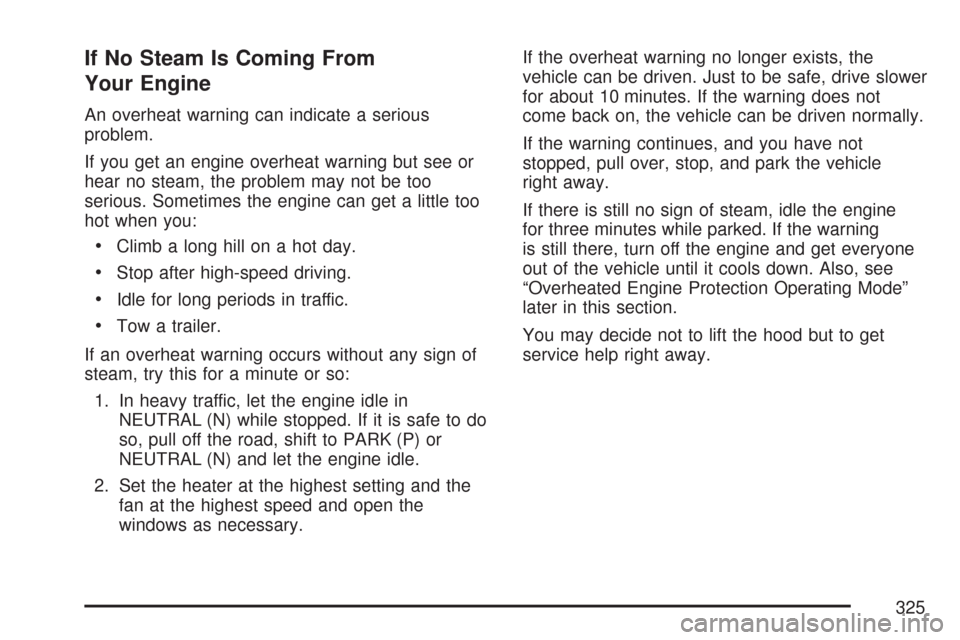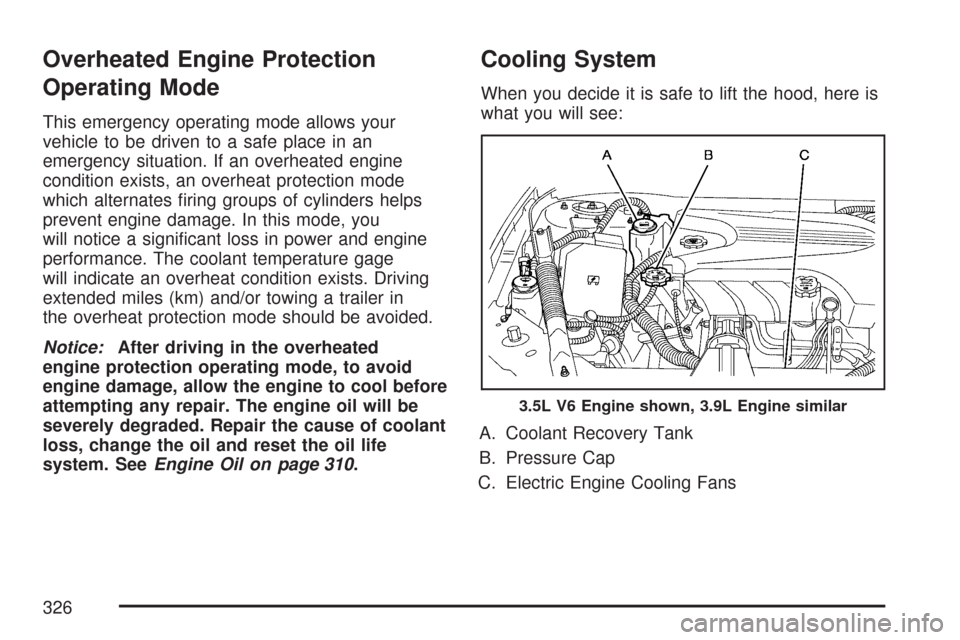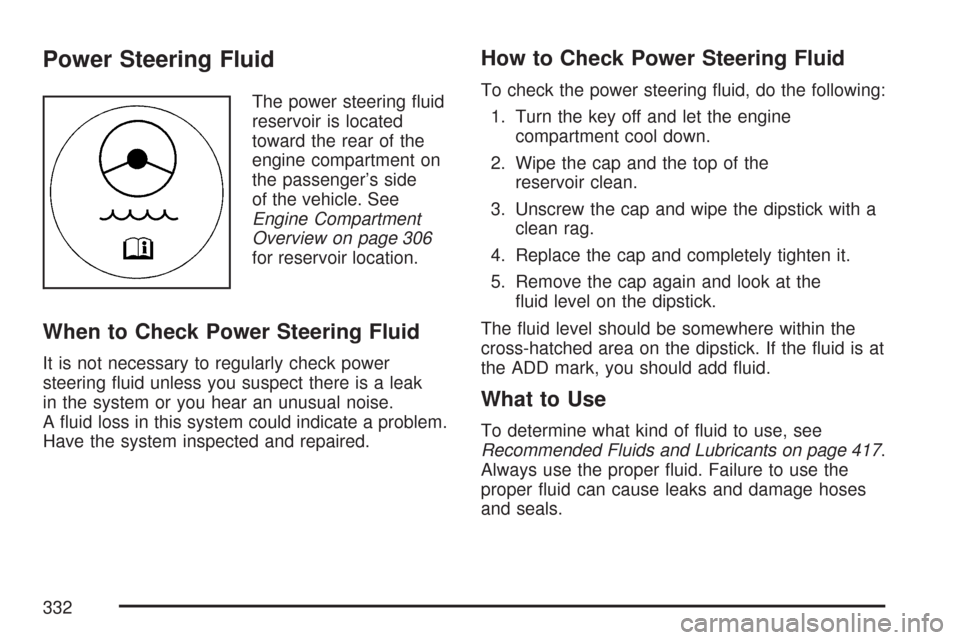Page 291 of 460

When You Are Ready to Leave After
Parking on a Hill
1. Apply your regular brakes and hold the pedal
down while you:
start your engine,
shift into a gear, and
release the parking brake.
2. Let up on the brake pedal.
3. Drive slowly until the trailer is clear of
the chocks.
4. Stop and have someone pick up and store
the chocks.
Maintenance When Trailer Towing
Your vehicle will need service more often when
you’re pulling a trailer. See the Maintenance
Schedule for more on this. Things that are
especially important in trailer operation are
automatic transmission �uid (don’t over�ll),
engine oil, drive belts, cooling system and brake
system. Each of these is covered in this manual,
and the Index will help you �nd them quickly.
If you’re trailering, it’s a good idea to review
this information before you start your trip.
Check periodically to see that all hitch nuts and
bolts are tight.
Engine Cooling When Trailer Towing
Your cooling system may temporarily overheat
during severe operating conditions. SeeEngine
Overheating on page 323.
291
Page 310 of 460
Engine Oil
If the ENGINE OIL LOW ADD OIL message
appears in the Driver Information Center (DIC),
check the engine oil level right away. For
more information, seeDIC Warnings and
Messages on page 199. You should check the
engine oil level regularly; this is an added
reminder.
Checking Engine Oil
It is a good idea to check the engine oil every time
you get fuel. In order to get an accurate reading,
the oil must be warm and the vehicle must be
on level ground.The engine oil dipstick handle is a yellow loop.
SeeEngine Compartment Overview on page 306
for the location of the engine oil dipstick.
1. Turn off the engine and give the oil several
minutes to drain back into the oil pan. If you
do not do this, the oil dipstick might not
show the actual level.
2. Pull out the dipstick and clean it with a paper
towel or cloth, then push it back in all the
way. Remove it again, keeping the tip down,
and check the level.
310
Page 316 of 460

Engine Air Cleaner/Filter
The engine air cleaner/�lter is located in the
engine compartment on the driver’s side of the
vehicle. SeeEngine Compartment Overview
on page 306for more information on location.
When to Inspect the Engine Air
Cleaner/Filter
Inspect the air cleaner/�lter at the MaintenanceII
intervals and replace it at the �rst oil change after
each 50,000 mile (83 000 km) interval. See
Scheduled Maintenance on page 408for more
information. If you are driving in dusty/dirty
conditions, inspect the �lter at each engine
oil change.
How to Inspect the Engine Air
Cleaner/Filter
To inspect the air cleaner/�lter, remove the �lter
from the vehicle and lightly shake the �lter to
release loose dust and dirt. If the �lter remains
caked with dirt, a new �lter is required.To inspect or replace the engine air cleaner/�lter
do the following:
1. Lift the �lter cover tabs on top of the engine
air cleaner/�lter housing.
2. Push the �lter cover housing toward the
engine.
3. Pull out the �lter.
4. Inspect or replace the engine air cleaner/�lter.
5. To reinstall the cover, position the tabs
through the hinges on the housing.
6. Push the cover tabs on top of the housing to
lock the cover in place.
316
Page 319 of 460
Then, without shutting off the engine, follow
these steps:
1. Pull out the dipstick and wipe it with a clean
rag or paper towel.
The transaxle �uid
dipstick handle is the
black loop with this
symbol on it. It is located
near the rear of the
engine compartment.
SeeEngine Compartment Overview on
page 306for more information on location.
2. Push it back in all the way, wait three seconds
and then pull it back out again.3. Check both sides of the dipstick, and read the
lower level. The �uid level must be in the
cross-hatched area.
4. If the �uid level is in the acceptable range,
push the dipstick back in all the way.
V6 Engines5.3L V8 Engine
319
Page 325 of 460

If No Steam Is Coming From
Your Engine
An overheat warning can indicate a serious
problem.
If you get an engine overheat warning but see or
hear no steam, the problem may not be too
serious. Sometimes the engine can get a little too
hot when you:
Climb a long hill on a hot day.
Stop after high-speed driving.
Idle for long periods in traffic.
Tow a trailer.
If an overheat warning occurs without any sign of
steam, try this for a minute or so:
1. In heavy traffic, let the engine idle in
NEUTRAL (N) while stopped. If it is safe to do
so, pull off the road, shift to PARK (P) or
NEUTRAL (N) and let the engine idle.
2. Set the heater at the highest setting and the
fan at the highest speed and open the
windows as necessary.If the overheat warning no longer exists, the
vehicle can be driven. Just to be safe, drive slower
for about 10 minutes. If the warning does not
come back on, the vehicle can be driven normally.
If the warning continues, and you have not
stopped, pull over, stop, and park the vehicle
right away.
If there is still no sign of steam, idle the engine
for three minutes while parked. If the warning
is still there, turn off the engine and get everyone
out of the vehicle until it cools down. Also, see
“Overheated Engine Protection Operating Mode”
later in this section.
You may decide not to lift the hood but to get
service help right away.
325
Page 326 of 460

Overheated Engine Protection
Operating Mode
This emergency operating mode allows your
vehicle to be driven to a safe place in an
emergency situation. If an overheated engine
condition exists, an overheat protection mode
which alternates �ring groups of cylinders helps
prevent engine damage. In this mode, you
will notice a signi�cant loss in power and engine
performance. The coolant temperature gage
will indicate an overheat condition exists. Driving
extended miles (km) and/or towing a trailer in
the overheat protection mode should be avoided.
Notice:After driving in the overheated
engine protection operating mode, to avoid
engine damage, allow the engine to cool before
attempting any repair. The engine oil will be
severely degraded. Repair the cause of coolant
loss, change the oil and reset the oil life
system. SeeEngine Oil on page 310.
Cooling System
When you decide it is safe to lift the hood, here is
what you will see:
A. Coolant Recovery Tank
B. Pressure Cap
C. Electric Engine Cooling Fans
3.5L V6 Engine shown, 3.9L Engine similar
326
Page 332 of 460

Power Steering Fluid
The power steering �uid
reservoir is located
toward the rear of the
engine compartment on
the passenger’s side
of the vehicle. See
Engine Compartment
Overview on page 306
for reservoir location.
When to Check Power Steering Fluid
It is not necessary to regularly check power
steering �uid unless you suspect there is a leak
in the system or you hear an unusual noise.
A �uid loss in this system could indicate a problem.
Have the system inspected and repaired.
How to Check Power Steering Fluid
To check the power steering �uid, do the following:
1. Turn the key off and let the engine
compartment cool down.
2. Wipe the cap and the top of the
reservoir clean.
3. Unscrew the cap and wipe the dipstick with a
clean rag.
4. Replace the cap and completely tighten it.
5. Remove the cap again and look at the
�uid level on the dipstick.
The �uid level should be somewhere within the
cross-hatched area on the dipstick. If the �uid is at
the ADD mark, you should add �uid.
What to Use
To determine what kind of �uid to use, see
Recommended Fluids and Lubricants on page 417.
Always use the proper �uid. Failure to use the
proper �uid can cause leaks and damage hoses
and seals.
332
Page 349 of 460
Replacement Bulbs
Exterior Lamp Bulb Number
Back-Up 921
Front Parking/Turn Signal 3157NAK
License Plate Lamp 194
Headlamps
High-Beam H9
Low-Beam H11
Sidemarker 194
Stoplamp, Taillamp, and
Turn Signal3057
For replacement bulbs not listed here, contact
your dealer/retailer.
Windshield Wiper Blade
Replacement
Windshield wiper blades should be inspected for
wear or cracking. SeeScheduled Maintenance
on page 408for more information on wiper blade
inspection.Replacement blades come in different types and
are removed in different ways. Here’s how to
remove the wiper blade:
1. Pull the windshield wiper arm connector away
from the windshield.
2. While holding the wiper arm, pull the clip up
from the blade connecting point, and pull the
blade assembly down toward the windshield
to remove it from the wiper arm.
3. Install the new wiper blade onto the wiper arm
and snap the clip down into place.
349